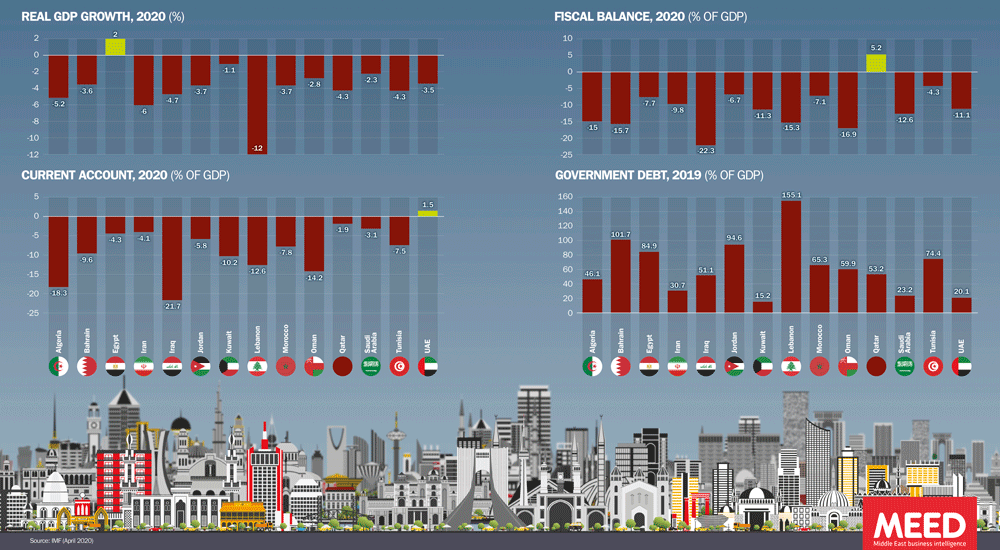Covid-19 will shape future business in the region

The IMF predicts a strong rebound in global GDP growth in 2021, but the effects of the Covid-19 pandemic will torment the Middle East market for years to come
Click here to enlarge the infographic
On 14 April, the IMF published its latest World Economic Outlook (WEO). The picture it painted could not have looked more different to the one it presented just three months ago in its January WEO update.
Dubbing its latest report ‘The Great Lockdown’, the fund said that Covid-19 will knock 6.3 per cent off its projected global economic growth in 2020 as a result of the lockdown measures taken to prevent the spread of coronavirus.

Nowhere is escaping the Covid-19 recession. The Middle East and North Africa (Mena) region will be hit severely.
The crash in oil prices and the collapse of tourism are having a devastating effect on the economies of the Mena region in 2020.
Regional outlook
While global GDP growth is projected to fall to -3.0 per cent in 2020, growth in the Mena region is expected to drop to -3.3 per cent, down 5.9 per cent on the 2.2 per cent growth projected in January.
The Mena region is being more severely hit than the global average in 2020 due to its exposure to lower oil prices, and also the outsized importance of travel and tourism in the region.
Nowhere is escaping the Covid-19 recession. The Middle East and North Africa (Mena) region will be hit severely
Covid-19 has exposed dependence on oil and tourism, but there are very few industries that are not affected and the fund’s bullish projection of a strong rebound of 4.2 per cent growth in 2021 – 1.2 percentage points above its January forecast – masks a much more painful outlook for the Mena region.
The 2021 recovery will be from an extreme low in 2020, and reflects merely a stabilisation in the oil markets from the chaos of March and April 2020, and a recovery in consumer spending and travel, which have been devastated by the lockdowns.
Oil impact
The sting in the IMF report for oil producers is the forecast of average oil prices of $35 a barrel in both 2020 and 2021, which is likely to be accompanied by reduced oil production levels.
With most governments in the region setting their 2020 and 2021 budget spending plans on an assumed oil price of $50-$80 a barrel, the projection of $35 a barrel means a significant rise in fiscal deficits and an inevitable rise in debt and reserve drawdowns to finance the deficits.
Covid-19 has exposed the twin chronic weaknesses of the Middle East economies – their overdependence on oil, and the dominance of the state in economic activity
While deficit levels of 30 per cent of GDP and government debt of 40 per cent or 50 per cent of GDP might be relatively normal in the global scheme, it is a paradigm shift for the region’s oil producers, who have become used to low debt and budget surpluses.
Spending cuts
The impairment of government and bank balance sheets will lead to cutbacks in government spending that will run for years and, in particular, cuts to capital spending on infrastructure.
 This will have knock-on consequences for the wider economy as a contraction in construction and projects will see fewer expatriates in the region and a fall in consumer spending.
This will have knock-on consequences for the wider economy as a contraction in construction and projects will see fewer expatriates in the region and a fall in consumer spending.
Ultimately, Covid-19 has exposed, yet again, the twin chronic weaknesses of the Middle East economies – their overdependence on oil, and the dominance of the state in economic activity.
Looking ahead
The projections for 2021 raise an interesting question.
Although probably too early to be meaningful, they will be of concern to governments in the region as growth will be more sluggish than in other regions. The question then is how to encourage stronger growth?
Those that can afford it will spend, and in the past when confronted with challenges like this those countries have responded with daring plans. Will we see such a response in 2021?
In response, we can expect to see a lot of talk about accelerating long-promised structural economic reforms to open up the investment markets and to privatise the public sector. But to work, more difficult social and legislative reforms will need to be delivered at the same time.


